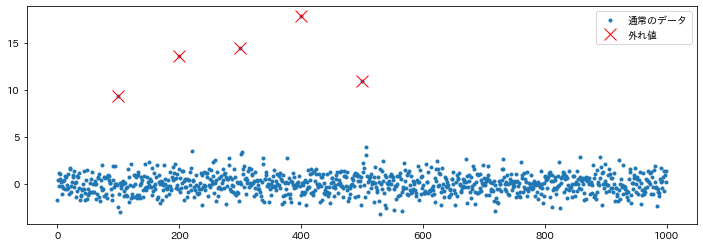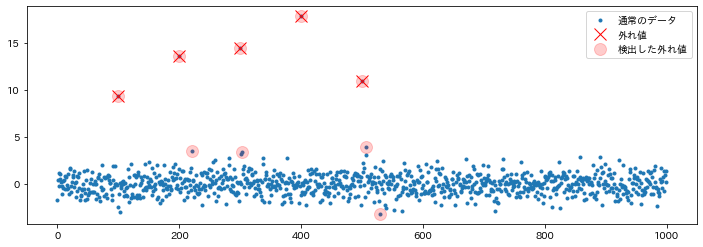外れ値にラベルを付与①
ホテリングの$T^2$法はデータに規分布を仮定した上で、各データの異常度が$\chi^2$分布に従うことを利用して外れ値を検出する手法です。このページでは、pythonを用いて正規分布で分布しているデータに含まれる外れ値にラベルをつけてみます。
実験用のデータ
stats.norm.rvs(size=n_samples)として正規分布からデータを作成し、その中にいくつかを外れ値を追加します。
from scipy import stats
import matplotlib.pyplot as plt
import japanize_matplotlib
import numpy as np
# 乱数固定のための指定
np.random.seed(seed=100)
# 実験用のデータ
n_samples = 1000
x = stats.norm.rvs(size=n_samples)
ind = [i for i in range(n_samples)]
# 外れ値のインデックス
anom_ind = [
100,
200,
300,
400,
500,
]
for an_i in anom_ind:
x[an_i] += np.random.randint(10, 20)
# プロットして確認
plt.figure(figsize=(12, 4))
plt.plot(ind, x, ".", label="通常のデータ")
plt.plot(anom_ind, x[anom_ind], "x", label="外れ値", c="red", markersize=12)
plt.legend()
plt.show()

外れ値を検出する
標本の平均値と分散を求め、そこから標本ごとの異常度のスコアを求めます。 予め指定した閾値を超えた異常度を持つデータを、外れ値として検出します。
from __future__ import annotations
def get_anomaly_index(X: np.array, threshold: float) -> list[int]:
"""一次元データ用外れ値インデックス取得
1次元のデータから異常値のインデックスを取得します
Args:
data (numpy.array): 検出対象のデータ
threshold (float): 外れ値として扱う閾値.
Returns:
list[int]: 外れ値であるデータのインデックスのリスト
Examples:
>>> print(get_anomaly_index(np.array([1, 2, 3, ..., 1]), 0.05))
[1, ]
"""
avg = np.average(X)
var = np.var(X)
scores = [(x_i - avg) ** 2 / var for x_i in X]
th = stats.chi2.interval(1 - threshold, 1)[1]
return [ind for (ind, x) in enumerate(scores) if x > th]
実際に検出できたかを確認する
detected_anom_index = get_anomaly_index(x, 0.05)
# プロットして確認
plt.figure(figsize=(12, 4))
plt.plot(ind, x, ".", label="通常のデータ")
plt.plot(anom_ind, x[anom_ind], "x", label="外れ値", c="red", markersize=12)
plt.plot(
detected_anom_index,
x[detected_anom_index],
"o",
label="検出した外れ値",
c="red",
alpha=0.2,
markersize=12,
)
plt.legend()
plt.show()
